The Deadly Shashka Sword Used by the Renowned Cossacks
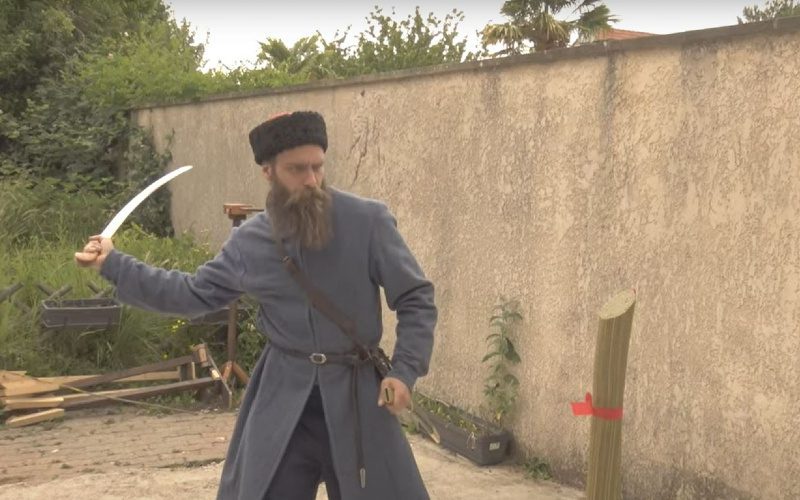
The Shashka or Shasqua Sword is a single-edged weapon widely known today as the primary sword used by the Cossacks while mounted on their horses. Originating sometime after the 13th century, the Cossacks were a group of Orthodox Christians from what are parts of Ukraine and Russia today. The Shashka is a very popular weapon that can be seen in many dances throughout Russia and Ukraine today.
It is one of the most popular sabres and has a unique look as it does not have a guard. This article will discuss the Shashka Sword, its types, unique characteristics, and how it was used. We will then go over its history, compare it with a regular sabre and explain why it does not feature a guard.
Types of Shashka Sword
Although the Shashka Sword has an iconic look, which causes it to stand out from other swords worldwide, there are generally two types that slightly affect how it looks and feels.
Caucasian / Circassian Shashka
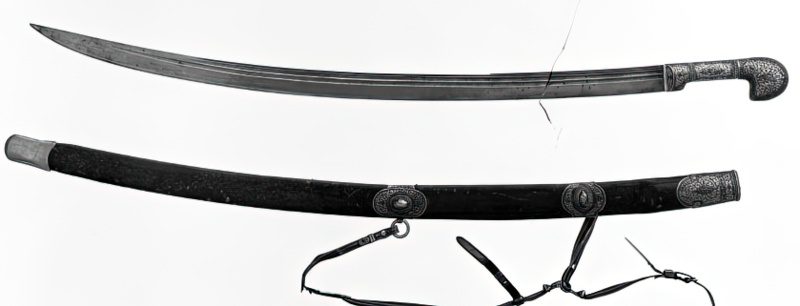
These types of Shashka Swords got their names from the Adyghe language and directly translated to long knife. It was used by the Kuban Cossacks and the tribes coming from the Caucasus regions. These types of Shashka were very light and were said to be longer than the Cossack Shashkas.
Cossack Shashka

The Cossack Shashka type is the sword used by the Cossacks that excelled in its ability to slash the enemy while in mounted warfare. This type of sword was very similar to the other type, except it was shorter and heavier, with a center of balance primarily for deadly slashing attacks. The weapon quickly gained popularity and was soon adopted by the Russian and became their standard-edged sword for the police force and the army.
Later Type

The popularity of the Shashka and its widespread use throughout Russia led to several modifications of the weapon to the point that some would no longer consider it a Shashka. One such example is that a knuckle guard was added to some causing it to look like a regular sabre while giving it the name Dragoon Shashka.
For other Shashkas, the size, weight, pommel, fullers, and curves were changed to reduce production cost and time.
Characteristics of the Shashka Sword
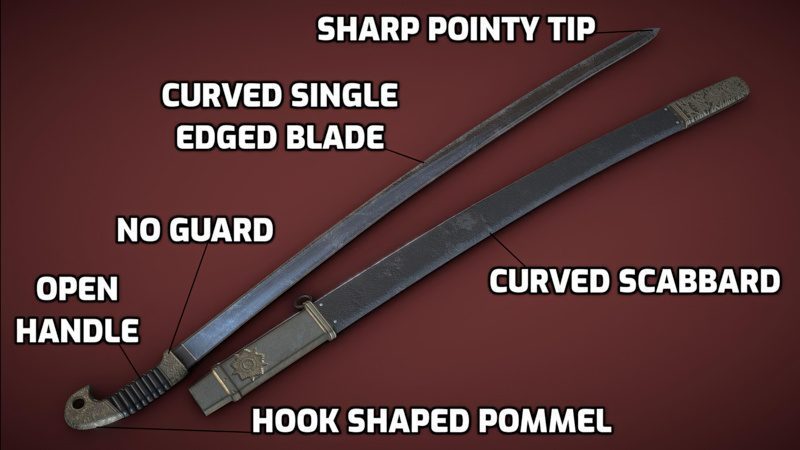
The Shashka sword is a saber with a unique look. The strongest characteristic of the Shashka is that it lacks a guard. It also has a single-edged blade and a curved open handle with a bird-beak-like pommel. The sword is easily recognizable when sheathed.
Blade
The single-edged blade of the Shashka Sword has a slender curve. Because the blade is only sharpened on one side, it is mostly used for slashing. It tapers to a point at the end of the blade, which can also be sharpened on both sides to deliver deadly stab wounds to the opponent.
The material for the blade is made of carbon steel, and it is full tang, meaning that it extends through the handle and to the pommel. Sometimes it can be made with wootz Damascus steel or fullered to make it lighter. The center of gravity is on the blade and sometimes has a heavy tip. This differs from a European sabre and offers a stronger balance to ease in lacerating the enemy.
The most usual blade length for the Shashka Sword is 25 to 31 inches (65 to 80 cm) which is the ideal size for calvary or infantry.
Guard
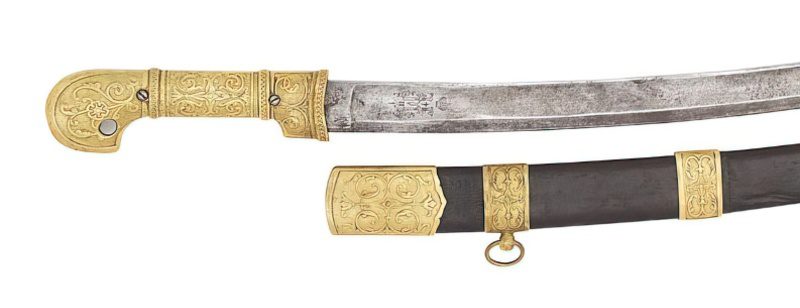
Along with lacking a guard, one of the unique elements of the Shashka Sword is that it has no quillons on the side or a knuckle guard to protect the user’s hands, making it a strictly offensive weapon.
Handle
The handle of the Shashka can be slightly curved or straight and moderately tips toward the guard. It widens where the guard would be or where the blade begins, acting as a hand stopper. It can be made of wood, brass, metal, or ivory and would have patterns or grooves, which would aid in the grip.
Because the handle of the Shashka is open, it must fit the user’s hand like a glove. The most common length is around 6 inches (15 cm).
Pommel
The Shashka has a curved or hooked pommel resembling a bird’s beak at its tip. This closed-off pommel is a strong support system against the back of the user’s hand, allowing for swift movements. With this pommel shape, the Shashka was an easy weapon to grip while still yielding a good amount of power.
Some forms of the Shashka are known to have an ear-typed pommel, which is split in the middle and widens as two ears would. This is believed by some to be a rifle rest point and is usually seen in Turkish swords like the Yataghan.
Scabbard
The Russian Cossack Shashka Sword has a curved scabbard that is as large as the blade itself. It is also curved like the blade and often has decorative art, ranging from the communist hammer and sickle to animals, depicted on it. It can be made out of wood, metal, or leather. The scabbard must be specifically designed for the Shashka it will be placed on to protect it from any water or debris.
When the Shashka is sheathed in the scabbard, it is usually worn with the blade’s tip pointing up, similar to how a Japanese Katana sword would be carried.
Length
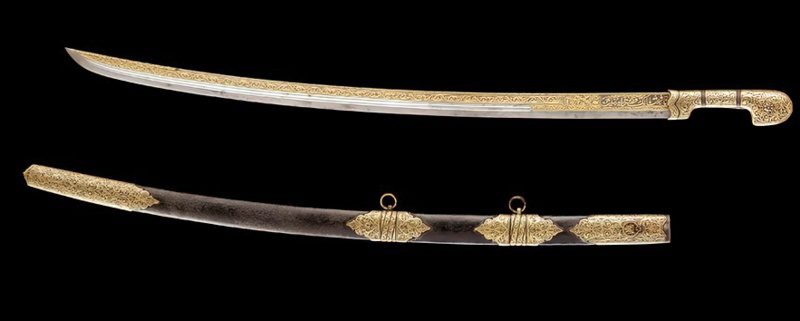
The Shashka Sword is relatively short, with the most common length from 31 to 41 inches (80 to 105 cm), making it possible for the sword to be used on foot or horseback.
Weight
The Shashka is a lightweight mounted weapon used for delivering precise strikes. The most common weight for the Russian Shashka is slightly under 2.2 lbs (1 kg).
Uses for the Shashka Sword
The Shashka sword is a light one-handed sword with a small handle, used mostly during calvary. It is a single-edged weapon primarily used for slashing the enemy, but because of its sharpened tip, it’s also useful for delivering thrusts.
Warfare
The biggest use for the Shashka Sword is warfare and combat. It was originally used by the Cossacks but then spread through the Russian empire, the Ottoman Empire, and Persia and was also used in World War II.
Prestigious Symbol
The Shashka Sword plays an important role in the Cossack community. Training with the weapon would begin while children were still very young. It played a very prestigious role as it passed through several generations of Cossacks, and with time its popularity spread to other cultures.
Shashkas were used by the Ottoman nobility, Persians, and the Russian Tsar Nicholas II was known to carry one. Russian military officers, as well as the police force, also used the Shashka, and they were highly decorated with expensive, rare metals as well as many symbols.
Modern Use & Dances
Its high status as a prestigious and powerful combat weapon makes the Shashka one of the most popular swords in Ukraine and Russia today. It is also a popular fencing weapon due to its unique appearance and design.
The Shaska is capable of swift movements from almost any direction, allowing one to have total self-defense. It can be seen in almost every LARP (live-action roleplay) and HEMA (historical European martial arts) event connected with the Cossacks and 19th-century Russia.
The Dance with Swords is still popular today and is performed in Russia and Ukraine using the Shashka Sword.
History of the Shashka Sword
The Shashka Sword originated with tribes indigenous to the Caucasus Mountains during the 13th century. It was adapted by the region’s Highlanders, using larger, though similar, daggers. The Shashka Sword as we know it today emerged in the late 17th century.
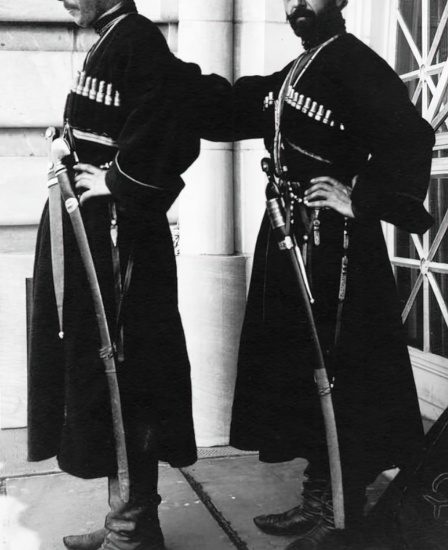
It was initially used by the Circassians, but when Russian Cossacks inhabited their regions, they quickly discovered the effectiveness of the weapons. With time they adopted it for themselves, and today it is a symbol of the Cossacks. They combined it with Dzigitovka, a form of stunt horseback riding, and the Shashka quickly became known as a deadly combat sword.
The use of the Shashka spread to neighboring lands very quickly and was soon designed by the Ottoman Empire, Persia, and in the German city of Passau’s workshops that are well known to sword enthusiasts. It was here, in the heart of Europe, that expert swordsmiths could be found designing the Shaska, often with beautiful engravings of the grey wolf.
Because of its effectiveness in battle, it was adopted by the whole of Russia. It would be used with the smaller Kindjal knife, similar to the Japanese Tanto and the Katana.
The Russians revised the Shashka, calling it the Baklanov Shashka, which was adopted by Cossack forces in 1838. It was a combination of the Shashka and the sabre and was given its name after the legendary Cossack general and enemy of the Circassians and the Chechens, Yakov Baklanov.
The weapon’s curved blade and off-center weight distribution made it capable of a fatal blow that could decapitate the enemy instantly.
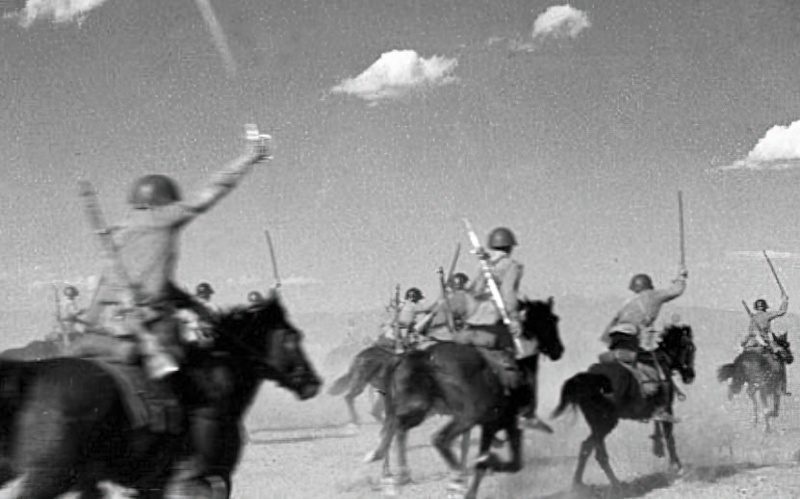
In 1881, Lieutenant General Gorlov led an armaments reform that standardized the design of bladed weapons across the Russian military. The blade was based on the traditional model used by Cossacks or on the Circassian Shashka Sword.
Just as it had achieved glory amongst some of the Cossack border guards, the sword had become a distinguishing symbol of the Russian army by the beginning of World War I.
The Shashka was adopted as the principal edged weapon of the Red Army during the 1917 Revolution, and it remained in service in Soviet cavalry regiments into World War II.
What is the difference between Shashka and a Saber?

The biggest differences between a Shashka and a European or Asian Saber are the styles of battles and fencing, the point of balance and weight, and the guard. The styles of fencing one can use with the Shashka are different than the locked hand movements of the European Saber. Due to the lack of a guard, various attack methods coming from several angles can be used in battle.
The Shashka Sword is a weapon used in a specific style of fencing that differs greatly from that performed with the European Saber. With the Shashka, one’s whole body is used, unlike just the hand and arm movement used with the Saber. The center of balance in the Shashka isn’t around the guard. Instead, it is spread throughout the blade, so the weapon performs better during an attack.
The other main visual difference between the Shashka and the Saber is that the Shashka does not have any type of guard that could defend the user’s hand. This lack of a defensive element leads to the question of why the Shashka doesn’t have a guard.
Why Doesn’t the Shashka Have a Guard?
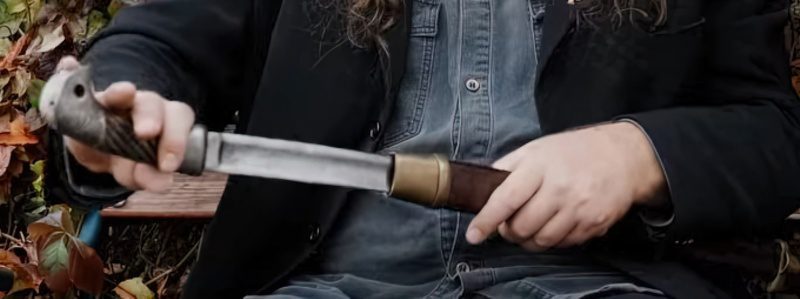
The Sword Shashka does not have a guard, bringing down the defense element that the crossguard offers. But at the same time, it also offers the Shashka Saber some positive elements to compensate for the lack of protection. Although they may be disputed, there are several possible reasons why the Shashka does not have a guard.
- Offensive Ability – the lack of a guard may be because the Shashka is strictly an offensive weapon to be used on horseback for quick slashing motions
- Changing Hands – the Shashka is a light weapon that can be thrown from one hand to the other while being used in fencing, duels, or on horseback. This gives the weapon much versatility, and the lack of a guard makes changing hands much easier
- Faster Slashing Ability – some users of the Shashka will say that by not having a guard, the slashing ability is possible immediately after taking it out of its scabbard
- Gloves – the cold winters of Caucasus regions and the Russian steppes brought the need to wear warm gloves, which would complicate the use of the weapon if it had a guard
- Pattern of Attack – the lack of a guard allows more freedom in the motions of attacks from all sides
- No Need for One – some historians may argue that with the introduction of firearms in battle, there was no need for a guard on the Shashka. As the Roman Gladius was without a guard, demanding the need of a large shield, the Shashka used on horseback had no benefit of having a guard allowing for fast slashing strikes and charges





